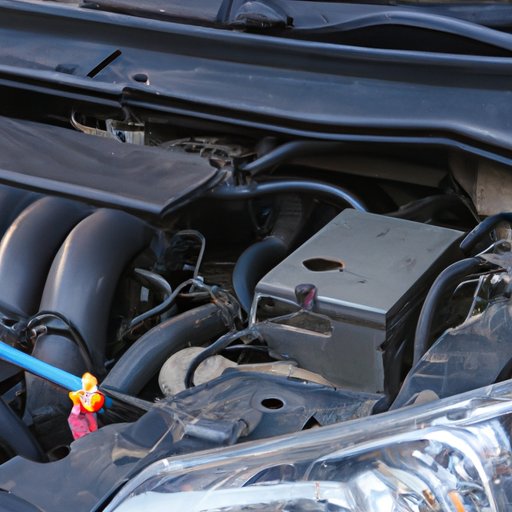I. Introduction
Engine overheating is a major concern for car owners. Overheating can cause serious damage to your engine and result in costly repairs. In this article, we will discuss common causes of engine overheating, prevention tips, DIY fixes, warning signs of engine overheating, what to do if your engine overheats, and troubleshooting engine overheating in specific makes or models.
II. Common causes of engine overheating
There are several common causes of engine overheating, including:
Malfunctioning thermostat
A malfunctioning thermostat can cause engine overheating by failing to open and close properly, disrupting the engine’s cooling system.
Low coolant levels
Low coolant levels can cause engine overheating because there is not enough coolant to regulate the engine’s temperature.
Faulty water pump
A faulty water pump can cause engine overheating because it is unable to pump coolant through the engine’s cooling system effectively.
Blocked or leaking radiator
A blocked or leaking radiator can cause engine overheating because it is unable to cool the engine’s coolant effectively.
Blown head gasket
A blown head gasket can cause engine overheating by allowing coolant to leak into the engine’s combustion chamber and reducing the engine’s cooling capacity.
Stuck radiator fan
A stuck radiator fan can cause engine overheating by preventing air from flowing over the radiator, reducing its ability to cool the engine’s coolant.
Clogged air filter
A clogged air filter can cause engine overheating by obstructing airflow to the engine, causing it to run hot.
Engine oil issues
Issues with engine oil, such as low levels or poor quality, can cause engine overheating by reducing lubrication and increasing friction in the engine.
III. Prevention tips for engine overheating
Prevention is key when it comes to avoiding engine overheating. Here are some prevention tips:
Schedule regular maintenance
Regular maintenance, including oil changes and coolant flushes, can help prevent engine overheating by identifying potential issues early on and keeping the engine running smoothly.
Check fluid levels regularly, including coolant and engine oil
Regularly checking fluid levels can help prevent engine overheating by ensuring that the engine has enough coolant and oil to function properly.
Avoid harsh driving conditions
Avoiding harsh driving conditions, such as steep inclines and heavy traffic, can help prevent engine overheating by reducing strain on the engine.
Keep an eye on temperature gauge
Keeping an eye on the temperature gauge can help prevent engine overheating by alerting you to any changes in engine temperature.
Avoid driving in hot weather when possible
Avoiding driving in hot weather, or using an air conditioner while driving, can help prevent engine overheating by reducing the strain on the engine.
Consider installing a temperature gauge or warning system
Installing a temperature gauge or warning system can help prevent engine overheating by alerting you to any changes in engine temperature and allowing you to take action before the engine overheats.
IV. DIY fixes for engine overheating
There are several DIY fixes that can be used to address and prevent engine overheating:
Replace a thermostat
Replacing a malfunctioning thermostat can prevent engine overheating by ensuring that the engine’s cooling system is functioning properly.
Flush a radiator
Flushing a radiator can prevent engine overheating by removing any blockages in the radiator that may be preventing it from cooling the engine’s coolant.
Clean a clogged air filter
Cleaning a clogged air filter can prevent engine overheating by allowing air to flow more freely to the engine, preventing it from running hot.
Check and replace engine oil
Checking and replacing engine oil can prevent engine overheating by ensuring that the engine has enough oil to lubricate its components and reducing friction.
Replace a radiator fan
Replacing a stuck radiator fan can prevent engine overheating by allowing air to flow freely over the radiator, cooling the engine’s coolant.
Check and replace hoses
Checking and replacing hoses can prevent engine overheating by ensuring that there are no leaks in the engine’s cooling system, allowing coolant to circulate freely.
V. How to identify the warning signs of engine overheating
There are several warning signs of engine overheating, including:
Steam or smoke from under the hood
Steam or smoke coming from under the hood can indicate that the engine is overheating and in danger of malfunctioning.
Engine temperature gauge rising quickly
The engine temperature gauge rising quickly can indicate that the engine is overheating and in danger of malfunctioning.
Strange smells or sounds from the engine
Strange smells or sounds coming from the engine can indicate that the engine is overheating and in danger of malfunctioning.
Check engine light remaining on
The check engine light remaining on can indicate that the engine is overheating and in danger of malfunctioning.
VI. What to do if your engine overheats
If your engine overheats, here are some steps you can take:
Safely pull over and turn off the vehicle
If your engine starts to overheat, pull over to a safe location and turn off the vehicle. Driving a vehicle that is overheating can cause further damage and put you at risk.
Open the hood and let the engine cool down
Open the hood to allow the engine to cool down. It is important to wait until the engine has cooled off completely before attempting any repairs.
Check coolant levels and other components
Once the engine has cooled down, check the coolant levels and other components, such as the radiator and water pump, to identify any issues that may have caused the engine to overheat.
Contact a tow truck or mechanic if necessary
If you are unable to address the issue on your own, contact a tow truck or mechanic to diagnose and repair the problem.

VII. Troubleshooting engine overheating in specific makes or models
There are common causes of engine overheating in specific cars or trucks. If you own a specific make or model, it is important to be aware of these issues:
Common causes of engine overheating in specific cars or trucks
For example, certain makes and models may be more prone to blown head gaskets or radiator issues than others.
Tailored advice for car owners who experience engine overheating
If you are experiencing engine overheating in your specific make or model, it is important to consult a mechanic for tailored advice on how to address the issue.
VIII. How to prevent engine overheating during long-distance travel
Long-distance travel in hot weather can put additional strain on your vehicle and increase the risk of engine overheating. Here are some tips for preventing engine overheating during long-distance travel:
Packing for emergency situations
Packing emergency supplies, such as coolant and oil, can help you address any issues that arise on the road.
Checking fluids and components before hitting the road
Before hitting the road, be sure to check all fluid levels and components to identify any issues before they become a problem.
Adapting driving styles during hot weather
In hot weather, it is important to drive more cautiously and avoid harsh driving conditions to reduce the strain on your vehicle.
Other tips for long-distance travel in hot weather
Other tips may include using an air conditioner while driving and taking regular breaks to allow the engine to cool down.
IX. Conclusion
In conclusion, engine overheating is a serious concern for car owners. By understanding common causes of engine overheating, prevention tips, DIY fixes, and warning signs, you can take steps to prevent engine overheating and avoid costly repairs. If you experience engine overheating, it is important to address the issue promptly to prevent further damage to your vehicle. By taking preventative measures and staying alert to warning signs, you can keep your engine running smoothly and avoid the headache of engine overheating.
